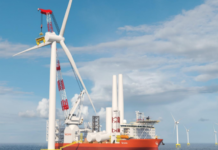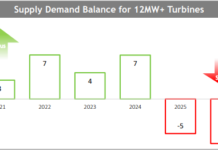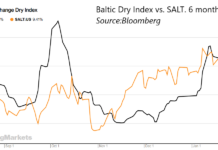Tom Konrad CFA
 |
| Offshore Wind Farm photo via Bigstock |
Wind tower stocks having opposite day, or rather opposite week.
When US-based wind power companies won a preliminary injunction to impose countervailing duties in a trade dispute against China, their stocks fell. They have continued to fall for the four trading days since the announcement. In fact, as the chart and table below show, wind tower stocks Trinity Industries (NYSE:TRN) and Broadwind (NASD:BWEN, red) have fallen more than the wind industry stocks as a whole (NYSE:FAN, green) and Siemens AG (NYSE:SI), the German energy conglomerate which argued against the tariffs.
According to a Dow Jones story Thursday, Siemens and Vestas (OTC:VWDRY) are the most likely companies to be hurt, since they are the biggest customers for Chinese wind towers in the US. While Siemens stock has declined less than the industry as a whole, only Vestas stock has declined as might be expected.
| Stock | Industry role | Change, 5/29 to 6/4 |
|
| FAN | Global Wind ETF | Wind industry as a whole | -4.3% |
| SI | Siemens | Chinese Wind Tower Customer | -6.1% |
| VWDRY | Vestas | Chinese Wind Tower Customer | -14.1% |
| BWEN | Broadwind | US Wind Tower Manufacturer | -6.9% |
| TRN | Trinity | US Wind Tower Manufacturer | -6.6% |
The Chinese wind tower companies hit by the tariffs are not publicly traded.
Yesterday, a reporter from the Financial Times‘ Deal Reporter called to ask me if I had any insight into the unexpected market reaction. My thoughts are these:
- These wins are not a big deal for these wind tower companies, since wind tower markets are fairly local because of high transportation costs.
- Wind tower stocks are probably not declining from fear of Chinese retaliation, since that would likely affect the whole industry, not just wind towers, yet FAN is down less than any of the involved parties.
- This trade dispute may be less about onshore wind towers today than offshore wind towers tomorrow.
Offshore vs. Onshore
There are several reasons I think this may case may really be preparation for a bigger dispute over offshore wind towers to come.
- Almost by definition, offshore wind farms will be accessible from ocean trading routes. Even proposed offshore wind in the Great Lakes is accessible via a series of locks.
- The towers and pilings are a much larger proportion of the cost of offshore wind farms than they are for onshore farms. According to Walt Musial, manager of offshore wind and ocean power systems at the National Renewable Energy Laboratory, turbines only account for 32% of the cost of an offshore wind farm. Onshore, the turbine accounts for 75% of wind farm costs.
- Siemens, the only company to argue against the tariffs, is a big player in offshore wind.
Conclusion
I think the stock market is telling us that the $222 million of Chinese wind tower exports today are small potatoes. This is just a prelude to the real fight, the fight over offshore wind towers.
Disclosure: No positions.
This article was first published on the author’s Forbes.com blog, Green Stocks.
DISCLAIMER: Past performance is not a guarantee or a reliable indicator of future results. This article contains the current opinions of the author and such opinions are subject to change without notice. This article has been distributed for informational purposes only. Forecasts, estimates, and certain information contained herein should not be considered as investment advice or a recommendation of any particular security, strategy or investment product. Information contained herein has been obtained from sources believed to be reliable, but not guaranteed.








